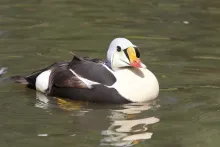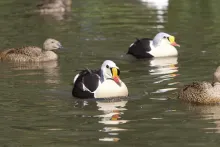
Eider, King (Somateria spectabilis)
Species name
- Dutch name:
- Koningseider
- English name:
- King eider
- German name:
- Prachteiderente
- French name:
- Eider à tête grise
- Scientific name:
- Somateria spectabilis
Scientific classification
- Order:
- Anseriformes
- Family:
- Anatidae
- Onderfamilie:
- Merginae
- Genus:
- Somateria
Description
- Description:
Male:
Male king eiders are one of the most ornately plumaged ducks in North America. In breeding plumage (late fall through midsummer), males sport a large orange yellow knob between their bill and forehead. Their forehead, crown, and nape is pearl blue, with iridescent pale green cheeks and a reddish orange bill. The lower portion of their head, neck, upper back, and breast is white with the remainder of the body black. The longest feathers along their upper flanks have triangular extensions that form a sail-like projection on their back.Female:
Female king eiders in breeding plumage are mostly dark reddish brown with extensive black barring along their sides and flanks. Their bill is olive or yellowish-gray and lacks the knob that the male has.Juvenile:
Dull grey brown, males gaining white breast and rump in late autumn and becoming darker above . Full adult plumage not tell third winter.
Standard Measurements
- Body Length (cm):
- The male (drake) of the Eider, King measures approximately 45-63 centimeters. The female measures approximately 45-63 centimeters.
- Body Weight (grams):
- The male will weight about 1180-2085 gram. The female will weight about 1180-2085 gram.
The weight is notoriously variable and can only be used as indication!
- Note:
Seaducks are generally winter-hardy and sociable. They are preferably kept on a large area of clean, cold, deep water, at least some of which (preferably half the area) should be more than 60cm and preferably more than1m deep. As with other diving ducks, most species are relatively ungainly on land and ponds should have shallow sloping banks. Some cover along the pond edges will generally be appreciated. Preferred nesting sites vary greatly within this group, from open ground nesting to thick vegetation and tree holes.
Diets of grain, pellets fish and seafood may be used, also bread. These ducks generally need a higher-protein diet than most waterfowl species and high-protein pelleted diets specifically designed for seaducks are now available, although supplementation with fish may still be important particularly for breeding.
Feeding in troughs containing stones may avoid the development of overgrown bills. Provision of salt water may decrease the incidence of fungal and other infections.
Ducklings may be given high-protein starter crumbs and live food, and provided with access to deep water for swimming from an early age.
Eiders should be provided with clean, deep, cold water, with ice-free water available in winter, and may be best kept as flocks rather than as individual pairs. They will eat large quantities of fish if it is offered. They are prone to Foreign Body Ingestion while searching for grit, and are also susceptible to heat stress and to Aspergillosis.
King eiders have not been commonly kept and have only been bred sporadically. King eiders female builds a scrape nest on the ground, usually near water. She lines it with vegetation and down feathers from her own body. Eggs laying mainly from May to June.
Seaducks are generally winter-hardy and sociable. They are preferably kept on a large area of clean, cold, deep water, at least some of which (preferably half the area) should be more than 60cm and preferably more than1m deep. As with other diving ducks, most species are relatively ungainly on land and ponds should have shallow sloping banks. Some cover along the pond edges will generally be appreciated. Preferred nesting sites vary greatly within this group, from open ground nesting to thick vegetation and tree holes.
May hybridise with all Somateria species e.g. Spectacled eider (Somateria fischeri) and Common eider (Somateria mollissima).
- Breeding:
- The female Eider, King usually lays from 4-5 pale olive eggs and incubates them for 22-23 days.
- Artificial incubating:
The ideal relative humidity for incubating most waterfowl eggs is 55% (ground nesters) and 40% (cavity nesters). The temperature is usually 37.4°C. Set ventilation as recommended by the incubator manufacturer. Eggs must be turned, either automatically or by hand, a minimum of 4 times a day. As the duckling develops there is a loss of water from the egg and the air sac gets bigger. In normal development of an egg with a 22-23 days incubation, the air sac occupies about a third of it three days earlier. Cleanliness is vital and ideally eggs should be moved to a separate hatcher at this point, where the humidity should be increased to 65% and even higher once they have pipped internally.
- Bird banding:
- Recommended closed leg band ring size for the Eider, King is 12 mm.The leg band ring can only be applied on a young sea duck at around 14 days old.
- It doesn't matter what leg that you band, but it's good to have a consistent system. Suggested: Left leg = Female, Right leg = Male
- Rearingfeed:
-

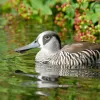


The best floatable special rearing feed from Lundi. This ideally balanced complete feed with 42% protein forms the perfect basis for the successful rearing of your ducks. The ducks grow well and have their perfect juvenile plumage after a short time.
Made exclusively from wholesome and selected raw materials, Lundi Micro 45 is also ideally suited for year-round feeding of waterfowl.
- Maintenance food:
-


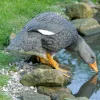
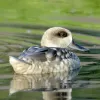



Floatable special complete food for sea birds with the highest nutritional requirements. Each chunk contains the complete nutrient spectrum. The high protein content of 35% ensures a healthy and species-appropriate diet. Spiral algae give a more magnificent coloration of plumage and sea salt promotes the salt gland.




Floating special complete food for sea birds with the highest nutritional requirements thanks to a particularly high protein content of 45%.
Ideal for daily feeding in animals that eat a lot of protein in their natural habitat. A must for "fish eaters".



